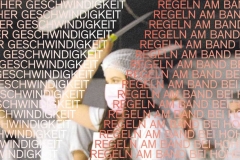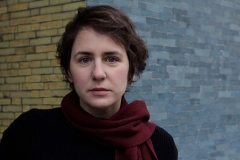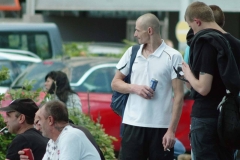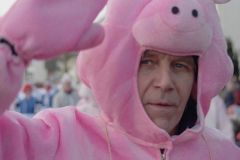Watch the film on Chili!
A small town in Western Germany is the last stop for 26,000 pigs per day and a brief home for masses of Eastern European temporary workers.
The workers of the largest slaughterhouse in the country are fighting for survival, while German activists who stand up for their rights are fighting against the local authorities.
At the same time, Munich high school students are working on the play “Saint Joan of the Stockyards” and trying to grasp the old text and German capitalism of our days.
Interwoven with the young people’s examination of the text in the rehearsals, the film deals in various fragments with conditions and facets of temporary work and labour migration in Germany.
CAST
Inge Bultschnieder
Peter Kossen
Alexander Klessinger
And all agency workers, whom we do not want to name in order to protect them.
CREW
Script and direction: Yulia Lokshina
Directors of Photography: Zeno Legner, Lilli Pongratz
Montage: Urte Alfs, Yulia Lokshina
Sound: Yulia Lokshina
Sounddesign: Andrew Mottl
Foley: Melanie Jilg, Cornelia Böhm
Sound Mix: Christoph Merkele
Color Grading: Andi Lautil
Producers: Isabelle Bertolone, Marius Ehlayil
Production management HFF: Christine Haupt
Project management HFF: Prof. Karin Jurschick, Prof. Tom Fährmann
Production: wirFILM in Zusammenarbeit mit HFF München
Funding: FFF Bayern (Abschlussfilm-Förderung)
Distribution Funding: Hessenfilm und Medien
Yulia Lokshina was born in Moscow in 1986. In 2011 she began studying documentary film directing at the University of Television and Film Munich. During her time at the HFF, she realised the short documentaries Days of Youth and After War, among others.
As part of her work at the Forum Internationale Wissenschaft at the University of Bonn, she creates parallel audiovisual projects at the interface of film and science as well as lectures and publications on the documentary.
Tage der Jugend premiered at the Duisburg Film Week in 2016 and was awarded the Starter Film Prize of the City of Munich in 2017.
For the experimental video work Subjektive Hill, she received the Kirch Foundation Media Art Scholarship in 2018 together with the artist Angela Stiegler, as well as the Videodox Förderpreis 2019. Her diploma film Regeln am Band, bei hoher Geschwindigkeit was awarded Best Documentary Film at the Max Ophüls Preis Film Festival 2020 and the megaherz Student Award at the Dokfilmfest München 2020.
2020 REGELN AM BAND, BEI HOHER GESCHWINDIGKEIT Documentary, 92 Min.
2019 SUBJECTIVE HILL, Exp. Documentary, 30 Min.
2017 AFTER WAR Documentary, 29 Min.
2016 TAGE DER JUGEND Documentary, 30 Min.
(text translated with DeepL)
The film begins with the story of a Polish worker who was pulled into a machine in a German meat factory under unclear circumstances and died. The few reconstructable individual parts of this case are repeatedly framed by the question of whether one can remember. Of course one cannot, it is one case among many. The prologue tries to point to a perspective with which we can look at a structure that always consists of individual cases and yet forms a system. When is something to be called an accident? And can someone be held responsible for an accident? The retelling of this case also explores the question of how we talk about something – how our language classifies and structures life.
The film turns to people who have no language. Not in the real sense, because they can communicate, of course, but they don’t know the language of contracts and footnotes that regulates their lives on the assembly line for a limited time. The assembly line that runs faster and faster and, like a dividing cell organism, keeps replenishing material even when the hands can’t keep up. The limitation of time is both a salvation, because it is the only way to endure this (working) time, and an evil. The agency workers have no time and no language in which they can organise themselves, in which they can declare solidarity with each other. We, bystanders, those looking on, have a language, but we don’t know exactly what to do with it. And so we talk and forget, justify and shame ourselves, distance ourselves from the matter, call for revolt, keep talking and forget again, with time.
At many points, the film is about what is not in view, what has been forgotten: hidden forest campsites, forgotten work accidents, the stretched time on the way home at night; about teachers who believe in protest and young people who do not want to rebel. About the invisible exploitation and vague helplessness in the face of global economy and personal everyday life. But also about the diffuse field that lies between those who suffer and those who are responsible. The field in which we locate ourselves with all our illusions and naivety. This space is created in the film between two narrative strands that circle around each other and comment on each other, between image and music that divide the flesh of the narrative into fragments and sew it up anew.
(text translated with DeepL)
INTERVIEW WITH YULIA LOKSHINA
How did it come about that you took on the topic of subcontracted labour in the meat industry?
Rules on the Line, at High Speed was my graduation film at the HFF Munich and was made without broadcaster involvement. With the graduation film, we wanted to make a film that had more or less to do with our immediate reality of life, about things that happen very close by and remain surprisingly invisible. I myself was born in Moscow and very much appreciate the freedom of movement of the European space. Nevertheless, the example of German meat production also shows what risks arise within a freedom through unregulated production.
What is the focus of your film?
The film is a reflection on the existing conditions, on how different strata in our society exist in parallel, why they do so and how this can last for years.
This concept of a parallel society is often used as a prop to keep a problem at bay. The problem is named and defined, but this also takes away the room for manoeuvre. We were less interested in gaining insights into these isolated communities than in taking a structural look at how such “parallel societies” are created and maintained.
How long did you shoot on location in NRW and Bavaria and what challenges did you face?
In total we researched for about 1 year, shot for another year and edited and post-produced during the 3rd year.
In NRW there was a lot of instability with the protagonists because of their work situation and contracts. If you met workers in February, you could not assume that they would still be there in May to accompany you. But relationships and trust take time. Besides the different languages, there were many emotional hurdles and uncertainties that had to be overcome first.
With the school class in Bavaria, it was easier organisationally, but again it was a risk. When we decided on the school and the teacher during the summer holidays, there was no group yet. So the future course of the rehearsals was very open and the group dynamics not yet foreseeable.
Corona has brought a lot of attention to the meat industry. How do you perceive the broad media coverage and outrage and what do you think will change now?
We have learned to integrate images and processes into our consciousness very quickly and thus to accept them. At the beginning of its spread, Corona acted like a kind of contrast agent with which what was overlooked could suddenly no longer be overlooked. However, it seems as if the distribution of risk has not shifted with it, but rather intensified for the time being. With visibility, new conditions have also arisen in which several thousand people in Gütersloh had to be quarantined and locked away behind construction fences. After the initial outrage, these images were also integrated too quickly into the collective consciousness as something given. After the first wave, slaughter is already underway again, people are living and working as before. For years, exploitation was a fundamental component of corporate policy and part of the corporate ethics in these factories. This does not change at once and certainly not by itself.
You never see working people or dead animals in the film. Why?
We could only have filmed in the factories under strict conditions, if at all, and only very specific processes. From the beginning, we were interested in the relationships between the people in these hierarchical chains – both vertically and between the workers on one level – and for these insights, time is needed. That’s why we shifted our film work to the outside locations, which are generally accessible, but which people often look past because they don’t seem to have such great visual value.
What was your cinematic approach? Was there a formal concept?
There are a lot of protagonists and places in the film. But faces usually play a more important role than places, so we decided on the 4:3 format. There are also almost no establishment shots in the film. Instead, there are repeated shots that are allowed to stand for quite a long time, that are held and make it possible to look in a different way. An emphatic look that goes beyond mere information, like the look at a pig that snaps at a ball for several minutes and never gets it.
The narrative strand of workers and activists is combined with Munich high school students rehearsing “Die heilige Johanna der Schlachthöfe” by Bertolt Brecht. How did this come about?
On the one hand, the play opens up a historical axis along which one can reflect on how certain problems and systems of exploitation can be maintained and not dissolved. On the other hand, with the play it was very exciting to observe what happens to our language with which we try to name problems and grasp things. Terms like workers’ struggle, socialism, redistribution and questions about radical system change seem very out of place at a Munich grammar school (as they do in public authorities, by the way), as if they had long since been processed and declared obsolete. We learn at school that we have a welfare state that takes care of us and a social market economy, and that everything is thus regulated. However, we often no longer have a language for the fact that this system also produces large gaps in which the “social” no longer applies, and we then see no possibility to act.
What is the response of young people and students to your film?
Surprisingly open. The students from the film have seen the film and some were surprised to see themselves again, the rehearsal process and the conflicts from a distance and to reflect differently. It is not easy to see oneself in a film anyway, especially not as a teenager. In addition, we had some screenings with school classes and the young people in the film offered them a personal introduction to the film and the topic.
What would you like to achieve with your film?
At the beginning of the pandemic, the enthusiasm for social and economic transformation was great and loud, but in many places, in the media, in politics, in private life, it quickly turned into frustration. At the end of “Saint Joan”, the character Joan, after many battles fought and lost against the meat kings and their helpers, comes to the realisation that the system needs a fundamental change. Brecht gives her the drastic words: “only violence helps where there is violence and only people help where there are people”. We heard this phrase many times in rehearsals during filming and they have changed over time. Many in our society understand a social and economic transformation as violence and I think it is about breaking away from this image.
What projects are you currently working on?
I am preparing an artistic-scientific project on documentary literary filming. And there is an idea for a documentary film with my aunt, who was an epoch-making Russian figure skating coach in the Soviet Union and who, despite her age, is still not retiring.
(text translated with DeepL)
FESTIVALS & AWARDS
“Sensitive, captivating from the first moment and multi-layered, the film opens our eyes to a major problem in our society. In a dramaturgically thickening narrative, he carefully draws our attention to what no one wants to see: the deplorable timelessness of the capitalist exploitation system also manifests itself in the middle of our society.
Without preaching, the film relies on observation, empathy and intellectual penetration of the subject matter. Through his filmic experimental arrangement, the director achieves a very unique approach that leaves the audience shaken.” Jury Max Ophüls Prize 2020
Film Festival Max Ophüls Prize – Winner Best Documentary
German Film Critics Prize 2020
Megaherz Student Award – DOK.fest MUNICH – Megaherz Student Award
German Film Critics’ Prize – nominated
Kassel Dok Fest – nominated A 38 Production Grand
Fünf Seen Film Festival
Doclisboa – Winner Healthy Workplace Award 2020
Recklinghausen Church Film Festival
Mecklenburg Western Pomerania Film Art Festival
Neisse Film Festival
Würzburg International Film Weekend – Competition 2021
Shortlist Rencontres Internationales Paris/Berlin
Brecht Festival 2021













